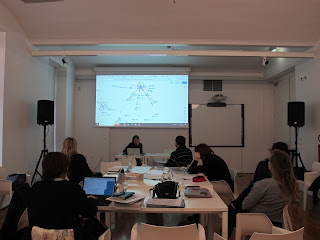The conference I REMEMBER THIS held on 8 October 2024, which was jointly organised by three archives on contemporary art that are part of the project Art Archives Study. Before and After 2004 was a one-day conference in Vienna with international guests that also met with great interest from students, artists, international archive partners and others.
In their joint two-year project co-financed by the EU, Moderna galerija Archives in Ljubljana, the Archive of Fine Arts in Prague and basis wien—Archive and Documentation Centre endeavoured to use their respective holdings to create a retrospective view of the change in the political landscape since the EU expansion by 10 countries in 2004.
It was the first attempt by the three archives to trace a specific period of time on the basis of exhibition histories and their theoretical reflections through published texts and interviews, along with organisation of and the presentation at the conference I REMEMBER THIS.
Preparations began with the setting up of an open call in order to use the conference as a communication space to reach the widest possible range of people. The project team subsequently received a number of interesting submissions, which were incorporated into the final programme.
A wide range of expert speakers made it possible to open up the conference to artistic, curatorial, theoretical and archival perspectives of the period concerned.
Daniel Grúň, art historian and curator, Senior Research Fellow at the Institute of Art History, Research Centre of the Slovak Academy of Sciences, highlighted the relationship between archives and the politics of the image in his lecture entitled Concern for the Archive and Situated Practice of Contemporary Art. As a starting point for his reflections, he referred to the artistic practice of artists like Tomáš Rafa, with his documentary films and in particular his participatory Wall Paintings. Over several years, the segregation walls in Slovakia, which visually manifest the social exclusion of the Roma, became the raw material for his artistic and political work.
Seda Yıldız, who is currently a PHD Researcher at the HDK-Valand, University of Gothenburg, Sweden, was able to provide details of her research work on The Role of Independent Curators in the Process of Self-historicization: Oral History as an Archival and Curatorial Tool. She has been collaborating with the Belgrade-based artist collective Škart for many years. As editor and co-author she recently published the book Building Human Relations Through Art: Škart Collective (Belgrade) from 1990 to the Present (Onomatopee, 2022).
In her presentation Secondary Archive. Female Voices, Iga Maria Szczepańska, an interdisciplinary artist working in the fields of performance, film, photography, who also runs the Katarzyna Kozyra Foundation, presented the Secondary Archive as an online database of the biographies and practices of female artists who have been marginalized, neglected, forgotten, or remain little known to the general public, alongside artefacts from key female figures of non-Western art.
The artist, Tanja Ostojić, an internationally renowned pioneer of institutional gendered critique presented her artwork Looking for a Husband with EU passport along with other artworks of hers that are directly related to political borders. Her insights and reflections from the perspective of an artistic practice itself over a period of 20 years was an important focus of the Art Archives Study project.
Zdenka Badovinac, former director of the Moderna galerija in Ljubljana and most recently director of Museum of Contemporary Art in Zagreb, presented The Collection as a Tool / ARTEAST 2000+, More Than a Collection, on the history of the creation and exhibition of the Arteast 2000+ collection, and an exploration of its background, a project that she initiated and which is closely linked to museum policy and the structural conditions of the period. The collection is an integral part of Moderna galerija Ljubljana`s permanent holdings.
Vít Havránek, an art historian, art theorist and curator based in Prague, focused in his lecture on remembering, by referring to Henri Bergson and examples of artworks and from exhibitions that explain the various levels of relationship between individual memory, situation and object. As in the work Educational Complex by Mike Kelley (1954 -2012), where memory and its gaps become form in the artist's attempt to reconstruct every educational institution he ever attended.
Dr Nicola Baird, a London-based curator and researcher, shared her insights into the exhibition project Arrivals: Art from the New Europe, Modern Art Oxford and Turner Contemporary 2005-2007: An Exhibition Case Study. This presentation showed the importance of the art-historical research in libraries and archives for the research process.
Finally, the archivist and art historian specialising in audio and video archives at the Artpool Art Research Center, Dóra Halasi, presented the artistic work of György Galantai. Taking his sustainable practice as an example, she was able to analyse the effects of Hungary's joining the EU 20 years ago by relying on the Active Archive Artpool, which was founded by György Galantai and Julia Klaniczay and is still active today.
The conference was accompanied by an archival exhibition featuring selected materials from the three archives connected to the project’s research. The exhibition is still on display at basis wien and has attracted numerous visitors to date.
Photos: Niki Weitzer
The documentation of the conference and lectures is stored in the archives and available for research on request.
The conference I REMEMBER THIS is part of the European project Art Archives
Study. Before and After 2004, co-funded by the Creative Europe
programme of the European Union (2023–2024).
Disclaimer: „Funded by the European Union. Views and opinions expressed are however those of the author(s) only and do not necessarily reflect those of the European Union. Neither the European Union nor the granting authority can be held responsible for them.“




























Comments
Post a Comment